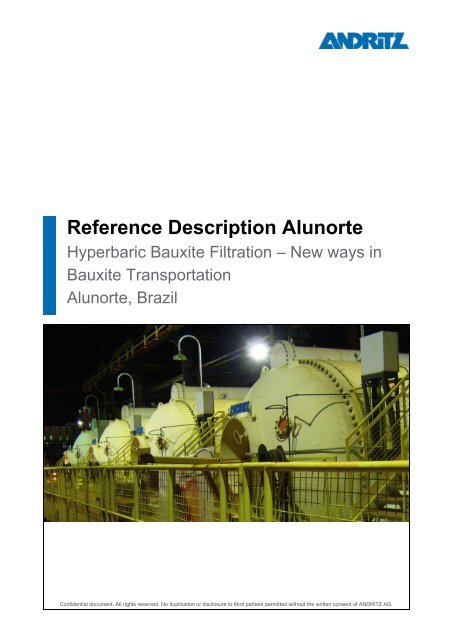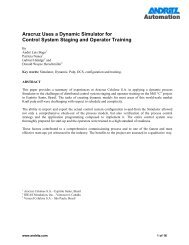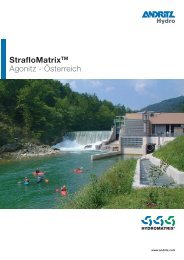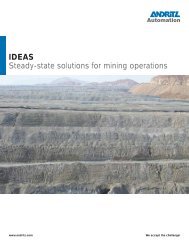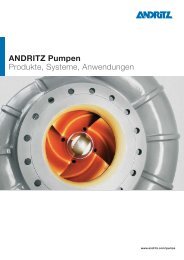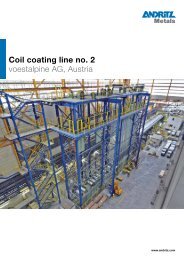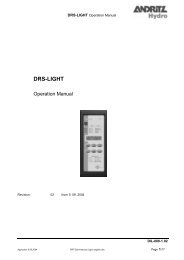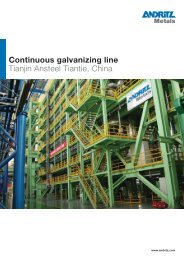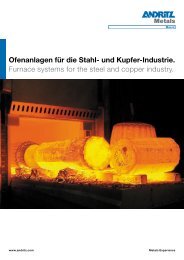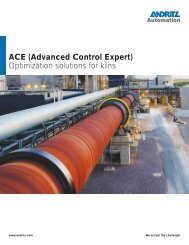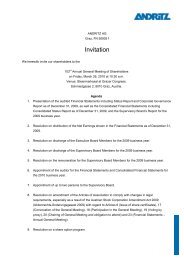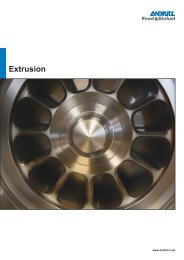Reference Description Alunorte - Andritz
Reference Description Alunorte - Andritz
Reference Description Alunorte - Andritz
You also want an ePaper? Increase the reach of your titles
YUMPU automatically turns print PDFs into web optimized ePapers that Google loves.
<strong>Reference</strong> <strong>Description</strong> <strong>Alunorte</strong><br />
Hyperbaric Bauxite Filtration – New ways in<br />
Bauxite Transportation<br />
<strong>Alunorte</strong>, Brazil<br />
Confidential document. All rights reserved. No duplication or disclosure to third partiers permitted without the written consent of ANDRITZ AG.
Abstract<br />
At Barcarena in northern Brasil, <strong>Alunorte</strong> has commenced processing of bauxite from the newly developed<br />
Paragominas mine. The challenge was to transport the bauxite over a distance of 260 km to the existing<br />
alumina refinery in Barcarena. Several options for transportation were studied. This resulted in <strong>Alunorte</strong>’s<br />
decision as the first company in the world to grind the bauxite, mix it with water and transport the suspension<br />
containing approx. 50% bauxite in a pipeline to the refinery. The next problem to be solved was to dewater<br />
the very fine bauxite to the low residual moisture content required by the existing refinery using the Bayer<br />
Process. Several options were investigated, the most promising being filter presses and hyperbaric disc<br />
filters. The decision was made in favourof the hyperbaric disc filter due to the continuous operation and lower<br />
investment costs. This resulted in the largest installation of hyperbaric filters in the world with a total filtration<br />
area of 840 m². This paper gives an overview of the whole investment project starting from the equipment<br />
selection process, the basic design of the plant, installation and start-up at the beginning of 2007.<br />
Introduction<br />
<strong>Alunorte</strong> is one of the world leading alumina refineries, located in Barcarena, north of Brasil. For its<br />
“expansion2” it processes bauxite from the newly developed Paragominas mine, which is located 260 km<br />
away. The area between the mine and the refinery lacks adequate infrastructure for transporting large<br />
quantities of ore.<br />
The technique of transporting minerals or ores in a pipeline is not generally a new technology. Pipelines for<br />
copper or other kind of ores can be found in several locations from Chile to China. Although the technique is<br />
not new it has never been applied for bauxite over such a long distance of more than 200 km.<br />
A railway line is well proven fortransporting ores, but the investment costs per km are 4 to 6 times higher<br />
than for a pipeline. Also with regard to operation and maintenance costs, the railway system is far more<br />
expensive. In addition the impact of a pipeline on the environment is much lower.<br />
<strong>Alunorte</strong> studied several options. The final decision was made to grind the bauxite, mix it with water and<br />
transport the suspension containing approximately 50% bauxite in a pipeline to the refinery, being the first<br />
alumina refinery in the world to use this kind of transport solution. For this challenging task the bauxite must<br />
be ground to a specific grain size. Flow velocity, pipeline design and slurry concentration require a specific<br />
range of bauxite grain size.<br />
The next problem to be solved was how to dewater this very fine bauxite suspension from a moisture content<br />
of 50 % to the water content acceptable for the Bayer process i.e. 12 to 15%. Several options were<br />
investigated. The most promising ones were filter presses and hyperbaric disc filters.<br />
ANDRITZ AG<br />
Separation Technologies<br />
Stattegger Strasse 18, 8045 Graz, Austria<br />
Tel.: +43 (316) 6902 2318, Fax: +43 (316) 6902 463<br />
separation@andritz.com, www.andritz.com<br />
Page 2 of 9
Although the filter presses had slightly lower equipment costs, the decision was made in favour of the<br />
hyperbaric disc filters, due to continuous operation, better dryness and lower overall investment costs. The<br />
sizing required the largest ever installation of hyperbaric filters with a total filtration area of 840 m².<br />
Dewatering of finely ground Bauxite<br />
The bauxite of the Paragominas mine proved to have a very specific grinding behaviour. This resulted in a<br />
grain size distribution with a d50 typically less than 50 microns. Especially the fraction
For filter cake drying by vacuum or blowing, Schubert’s theory [5] states that a relative degree of saturation<br />
arises (assuming next to ideal conditions):<br />
ANDRITZ AG<br />
Separation Technologies<br />
Stattegger Strasse 18, 8045 Graz, Austria<br />
Tel.: +43 (316) 6902 2318, Fax: +43 (316) 6902 463<br />
separation@andritz.com, www.andritz.com<br />
S Degree of saturation<br />
Sr<br />
pc<br />
pk<br />
Residual degree of saturation<br />
Cake permeability<br />
Capillary pressure<br />
t2 Dewatering time<br />
∆ Porosity<br />
hk<br />
Viscosity<br />
Cake thickness<br />
p Pressure<br />
Expressed in simple terms, as the residual moisture content of the cake drops, the higher the effective<br />
pressure difference becomes (pressure difference applied minus the cake capillary pressure). Vacuum<br />
filtration with a pressure difference of 0,5 to 0,7 bar therefore has its limits.<br />
Centrifuges have limits too. Especially the ultrafine particles (< 10 µm) cannot be separated with high Gforces<br />
and would be lost with the centrate.<br />
This equation shows that the filtration rate in terms of throughput per unit area of filter increases with the<br />
square root of the differential pressure. Increasing the temperature and thus reducing the Poiseuille[4] and<br />
others suggested one way to increase the specific throughput was by increasing the differential pressure<br />
across the filter medium. Placing a vacuum filter inside a pressure vessel allows much higher pressure<br />
differences. Adaptation of Poiseuille´s equation [4], which is usually applied to filtration, shows the following:<br />
∆p Pressure drop across filter<br />
W Weight of dry cake per unit volume<br />
µ Viscosity of liquid (filtrate)<br />
r Resistance of filter media<br />
t Cake formation time<br />
Viscosity of the filtrate would be a theoretical option, but an enormous amount of steam would be required to<br />
heat up such high quantities of material.<br />
Page 4 of 9
Practical investigations done on the installed base of Vacuum Filters (VF) and Hyperbaric Filters (HBF) have<br />
been performed by <strong>Andritz</strong> and are summarised in Figure1 below:<br />
Figure 1: Practical experience with vacuum and hyperbaric filtration (6)<br />
Equations (1) and (2) are principally confirmed by Figure 1. Both the residual moisture and throughput<br />
increase significantly if the pressure difference is increased.<br />
Using cake blowing technology, the filter press can basically deliver similar dryness values. For smaller<br />
throughputs and coarser material filter presses can be an economic alternative. Both systems – hyperbaric<br />
filtration and filter presses had been tested and finally the HBF technology was selected by <strong>Alunorte</strong> due to:<br />
� very high specific throughput resulting in a reasonable number of units<br />
� high pressure operation (applicable pressure difference up to 5,8 bars) for filtration giving excellent<br />
dryness<br />
� continuous operation<br />
� lowe roverall cost<br />
ANDRITZ AG<br />
Separation Technologies<br />
Stattegger Strasse 18, 8045 Graz, Austria<br />
Tel.: +43 (316) 6902 2318, Fax: +43 (316) 6902 463<br />
separation@andritz.com, www.andritz.com<br />
Page 5 of 9
Filtration Equipment HBF<br />
The principal procedure of <strong>Andritz</strong> Hyperbaric Filtration (HBF) is illustrated in Figure 2.<br />
ANDRITZ AG<br />
Separation Technologies<br />
Stattegger Strasse 18, 8045 Graz, Austria<br />
Tel.: +43 (316) 6902 2318, Fax: +43 (316) 6902 463<br />
separation@andritz.com, www.andritz.com<br />
1 Pressure vessel<br />
2 Manhole<br />
3 Filter disc<br />
4 Control head<br />
5 Filter drive<br />
6 Filter feed trough<br />
7 Agitators (option)<br />
8 Discharge device<br />
9 Compressed air supply<br />
10 Filtrate drainage<br />
11 Cake discharge<br />
Figue 2: Main components of an <strong>Andritz</strong> Hyperbaric Pressure Filtration Unit (HBF)<br />
The suspension is pumped into a filter trough (item 6) preferably by a helical rotor pump with variable speed<br />
drive. For suspensions that tend to settle an agitator can be installed there as an option.<br />
Approx. 50% of the discs consisting of 20 segments are submerged.The filtration itself is done by the same<br />
steps as in a vacuum filter. It consists of the sequence cake forming –dewatering -snap blow. Due to the 4 to<br />
5.8 bar overpressure in the pressure vessel, dewatering is very efficient.<br />
After cake forming and dewatering (drying) the cake is discharged by the snap-blow device and transported<br />
via a chain or belt conveyor towards the discharger.<br />
The discharge is one of the keys to this technology. The discharger must not only carry the load of the cake<br />
(approx. 2 – 3 tons/cycle), it must also support the load resulting from the pressure in the pressure vessel.<br />
This load can be more than 100 tons under normal operation conditions. Two gate valves open alternatively.<br />
Page 6 of 9
All the components undergo the highest quality inspections. Special emphasis is laid on the sealing system<br />
and to the design of the knife gate. The principal cycle of discharging is shown in Figure 3. Minimum cycle<br />
time is approx. 1 minute. It is controlled automatically by time switch or level probe in the upper/cake<br />
receiving chamber.<br />
Figure 3: Discharge cycle of HBF plants<br />
The production capacity of the filter depends on the parameters:<br />
• selected pressure in the vessel<br />
• rotating speed of thefilter shaft<br />
• speedof slurry feed pump<br />
These parameters can be set by the operator. The whole process runs automatically and needs only<br />
supervision from the operators in the remote control room. Hourly inspections of the filters are<br />
recommended. Details of this technology have been published in [2, 3, 4].<br />
ANDRITZ AG<br />
Separation Technologies<br />
Stattegger Strasse 18, 8045 Graz, Austria<br />
Tel.: +43 (316) 6902 2318, Fax: +43 (316) 6902 463<br />
separation@andritz.com, www.andritz.com<br />
Page 7 of 9
Bauxite Filtration Plant at Barcarena / Brasil<br />
Figures 4a and 4b depicts the bauxite filtration plant of <strong>Alunorte</strong> do Brasil at Barcarena (expansion 2). It is<br />
comprised of 5 <strong>Andritz</strong> HBF units, each one having a filtration area of 168 m2. 5 further units are under<br />
construction at the moment and will be put into service during 2008 (expansion 3). The pipeline has already<br />
been built to include the production of expansion 3.<br />
To avoid sedimentation a minimum flow velocity is required in the pipeline. Thus their operation is at present<br />
intermittent. Each storage tank can hold approx. 8 hours of pipeline slurry, which is afterwards pumped to an<br />
intermediate tank. This minimizes the distance between the slurry pump and the HBFs.<br />
Figure 4a: 5 units each 168 m² filtration<br />
area, operation pressure 5.8 bar<br />
Figure 4c: <strong>Andritz</strong> HBF 168 m² (inside view)<br />
ANDRITZ AG<br />
Separation Technologies<br />
Stattegger Strasse 18, 8045 Graz, Austria<br />
Tel.: +43 (316) 6902 2318, Fax: +43 (316) 6902 463<br />
separation@andritz.com, www.andritz.com<br />
Figure 4b: HBF Bauxite Filtration plant at<br />
<strong>Alunorte</strong> do Brasil in Barcarena<br />
Figure 4d: Bauxite slurry tanks<br />
Page 8 of 9
Operation experience project implementation<br />
Only 17 months after the project start, the plant received suspension for the first time. After this the pipeline<br />
capacity was ramped up continuously and the whole system (mine-pipeline-filtration) achieved round the<br />
clock operation in March 2007.<br />
Figure 5: Time schedule of HBF project (schematically)<br />
Essential parameters for the performance are:<br />
� slurry concentration<br />
� grain sizedistribution<br />
� filter cloths<br />
� selected operation pressure<br />
The best combination of these parameters is left to the experience of the operator. Each parameter<br />
influences the results interms of throughput and residual moisture individually and can be influenced by the<br />
operator to a certain extent.<br />
Conclusion<br />
The successful practical application of hyperbaric filtration technology to the new field of bauxite filtration has<br />
enabled a new way of bauxite transport. Continuous operation combined with high applicable pressure are<br />
the main advantages of this technology. The installation of a pipeline in the Amazon region has shown that it<br />
is not only cheaper than conventional rail transport, but has the added benefit that the environmental impact<br />
is minimized. This technology may open up an economic way to exploit mines in remote areas.<br />
ANDRITZ AG<br />
Separation Technologies<br />
Stattegger Strasse 18, 8045 Graz, Austria<br />
Tel.: +43 (316) 6902 2318, Fax: +43 (316) 6902 463<br />
separation@andritz.com, www.andritz.com<br />
Page 9 of 9


